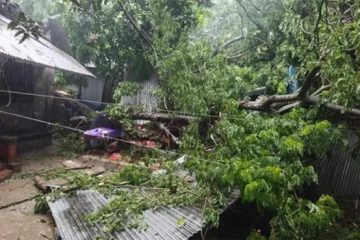 The dwindling size of farms, rise in landlessness and constant depletion of farmland are posing formidable threats to Bangladesh’s agriculture, increasing poverty and trapping many ultra-poor people in a vicious circle, according to various reports.
The dwindling size of farms, rise in landlessness and constant depletion of farmland are posing formidable threats to Bangladesh’s agriculture, increasing poverty and trapping many ultra-poor people in a vicious circle, according to various reports.
The average farm size has been reduced to less than 0.6 hectares and the percentage of landless people stands at 58 in a country where nearly 80 per cent of the ultra-poor live in rural areas.
Official statistics also show that the country is losing more than one per cent or 80,000 hectares each year from its original 13 million hectares of cropland due to urbanisation, industrialisation, unplanned rural housing and infrastructure building.
Agriculture accounts for only 21 per cent of the country’s gross domestic product although the sector employs around 50 per cent of the national workforce, according to the Bangladesh Economic Review 2008.
However, the country’s problem of landlessness has emerged as an international issue with the non-functioning of a rule-based global trading regime which has deprived Bangladesh of required supports to overcome the nagging domestic problems of food and agriculture.
The director-general of the World Trade Organisation, Pascal Lamy, recently referred to this critical issue at an international forum, pointing out that in the world’s poorest corners, including Bangladesh, land is getting divided through inheritance and farm sizes are getting smaller and smaller with the passing of every generation.
A Washington-based International Food Policy Research Institute, in its recent report titled ‘New Findings on the World’s Most Deprived: Characteristics and Causes of Extreme Poverty and Hunger’, mentioned that the incidence of landlessness was 58 per cent.
Also, the number of farms in Bangladesh has doubled over the past 20 years, increasing the number of farms smaller than 0.2 hectares in size proportionately, said the World Bank in its ‘World Development Report 2008: Agriculture for Development’. ‘This is a major cause of rural poverty, said the WB.
Pascal Lamy expressed his conviction that even the most sophisticated international trade policies would not provide incentives to agriculture in poor countries unless problems like environmental challenges and dwindling farm size were addressed by supportive domestic policies.
‘In Bangladesh the situation is worse,’ Lamy observed in a speech to the International Food and Agricultural Trade Policy Council in Salzburg, Austria, on May 10.
The average size of farms diminished from 1.4 hectares to 0.6 hectares between 1960 and 2000. The increase in the number of farms has triggered a rise in landlessness, he said.
The only crop whose area of cultivation is increasing over the past decades is rice. According to the Bangladesh Annual Economic Review 2008, the size of the area in which pulses were cultivated shrank further to 7.69 lakh acres with output declining to 2.58 lakh tonnes in 2006-07 from 17.15 lakh acres with production of 5.28 lakh tonnes in 1996-97. The country’s oil seed production was 3.22 lakh tonnes from 7.84 lakh acres in the 2005-06 fiscal year compared to 4.78 lakh tonnes on 13.7 lakh acres in the 1996-97 fiscal year. Production of wheat also dropped from 14.54 lakh tonnes on 17.49 acres of land in 1996-97 to 7.37 lakh tonnes on 9.88 lakh acres in the 2006-07 fiscal year.
An earlier global report, titled ‘Climate Change as a Security Risk’, said that the probable loss of arable and residential lands through flooding in this part of the world [Bangladesh and its neighbourhood] would result in increase of internal and external environmental migration and strained relations between countries.
‘No matter how sophisticated our trade policies may be, if domestic policies do not themselves incentivize (sic) agriculture, and internalize negative social and environmental externalities, then we will always have a problem,’ said Lamy.
Uttam Kumar Deb of the Centre for Policy Dialogue recommended that a solution to the issue of farmland depletion could be formulation of a sensible and realistic land-use policy. ‘We have to find out why people are becoming landless and how to solve the problem of shrinkage of arable land. Only then can necessary measures be taken,’ he told New Age.
Lamy sounded a positive note by claiming that Bangladeshis, on an average, spent 60 per cent of their income on food in 1990 and that sum is said to have come down to 50 per cent now. However, he regretted that ‘the world does not have a shared vision of what global integration should look like and what it can deliver in agriculture’.
‘Global integration must also allow food, [animal] feed and fibre to travel from countries where they are efficiently produced to countries where there is demand,’ he argued.
Saying that some of the world’s poorest countries have taxed agriculture the most, and that reinvestment of tax revenue in agriculture has been low, Lamy stressed the need for focussing first on national agriculture and food policy.
According to him, land management, natural resources management, water availability, property rights, enforcement, storage, transportation and distribution infrastructure, credit systems, and science and technology are all key elements of the solution of the agriculture and food security puzzle.
Image: connect-bangladesh.org




















